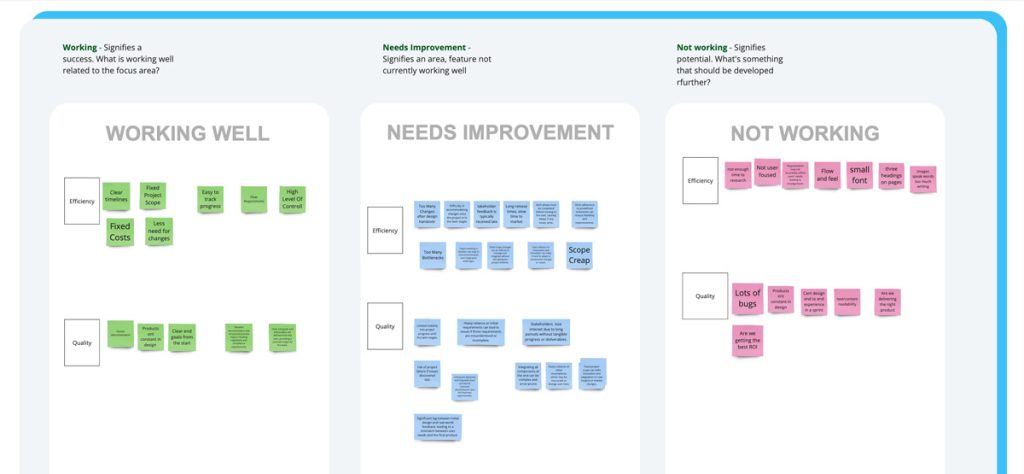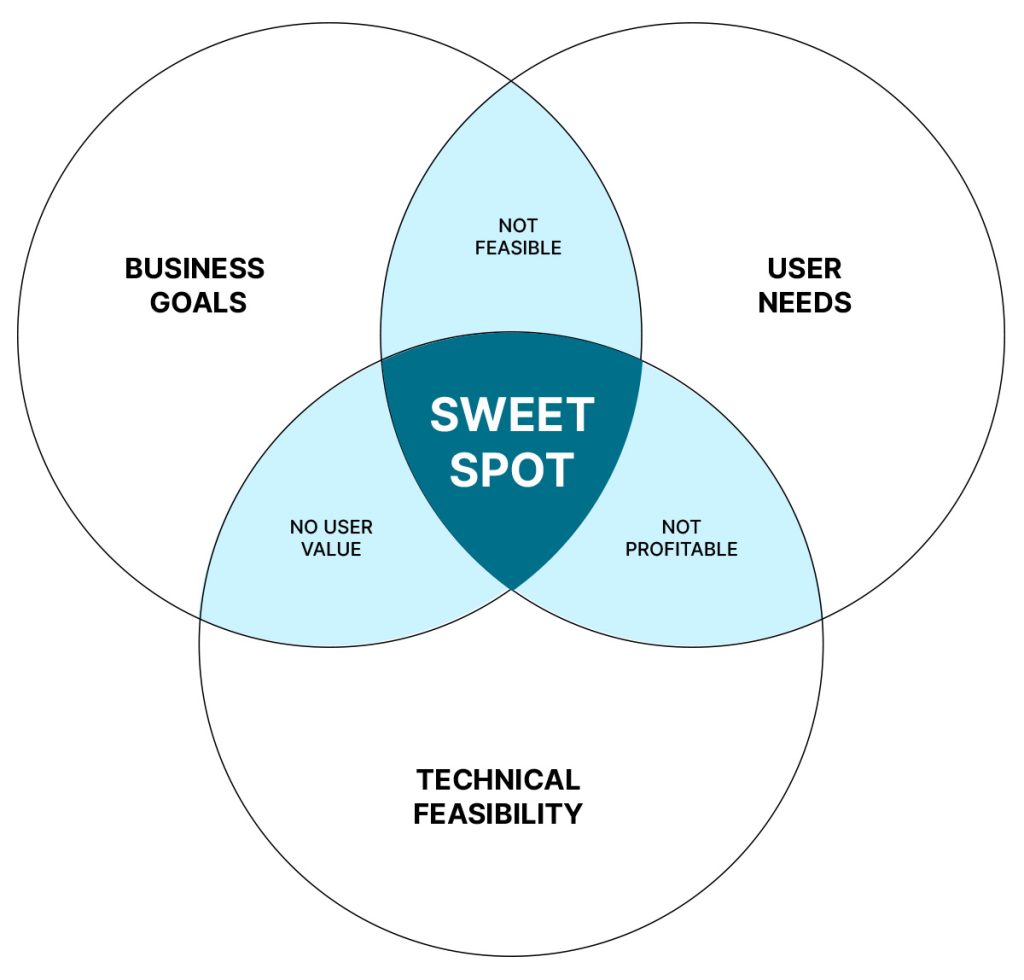Design Ops Lead
Design Ops / Product Design Frameworks
I’ve had the opportunity to work with various companies, addressing common challenges design teams face. These challenges often include adapting to developer sprints while designing end-to-end solutions, project managers’ concerns about the extensive research efforts, and misalignment between user needs, business goals, and technical feasibility. My objective has always been to streamline processes and improve collaboration across design, development, and product management teams. With a core priority of delivering value for both the company and its users
— The Process
Discovery
Team Interviews
Team Retrospectives
Data Analysis
Heuristic Evaluation
Ideate
Brainstorming Workshops
Process Diagrams
Design
Product Design Playbooks
Workshop Templates
Validate
Quantitative Data Analysis
Qualitative Data Analysis

— Problem Statement
Throughout my experience optimising design processes within teams, I have encountered several pervasive challenges that hinder effective product delivery across various organisations.
At Atlassian, which has a design organisation of over 600, we found teams faced various challenges. Designers often struggled with variations in design quality due to a lack of standardised guidelines and practices across dispersed teams. As teams and projects grew, scaling design processes became increasingly tricky, complicating efforts to maintain consistency, alignment and efficiencies.
In fast-paced environments such as marketing and digital agencies, tight deadlines often lead to shortcuts in research and validation. Project managers frequently expressed concerns about over-investing in research and discovery phases, fearing that it would delay project timelines and increase costs. The pressure to deliver quickly often compromised the overall quality of the product and the need to measure success.
With teams heavily tech-focused at Crown, Designers often struggled to create end-to-end solutions while adapting to teams’ agile development sprints. This misalignment frequently resulted in tech-driven and poorly validated solutions, with developers receiving functional and design changes just before a release, leading to rushed adjustments and compromised quality. Poor communication between design, development, and product management teams often led to misaligned expectations and outcomes, further complicating the design process.
— Approach
Not all projects face the same challenges; therefore, I always empathise that teams need guidance on processes flexible enough to meet the specific needs of each project. Just as sports teams adapt strategies and have playbooks to adjust weekly, seasonally, and long-term to face key challenges, design teams must also have adaptable methodologies. However, alignment across teams and disciplines is essential to avoid the typical scenario of “schoolyard football,” where everyone runs around doing their own thing.
— Understanding the Problems
Understanding core problems across all team members—from designers and project managers to developers and content designers—provides crucial context for identifying key areas to address and tracking performance improvements. Conducting workshops, reviewing data from team retrospectives, and auditing past case studies helps identify and quantify issues.

Analysing retrospective data has always helped identify recurring issues and successful strategies. Assigning severity scores to process-related issues for benchmarking helps track success of process changes.
Workshops helped teams map current tasks and processes, identifying frustrations and opportunities. By examining other frameworks, teams could evaluate and comment on other workflows, identifying improvement opportunities.
Auditing past case studies involved heuristically reviewing them with team members to critique processes and suggest improvements. Assigning scores based on effort and value aids in benchmarking against future projects.
Through these methods, I could gain a clear understanding of key areas to address, ensuring that process improvements are well-informed and target actual pain points, leading to more effective and cohesive workflows.
— Defining Process
Setting up a common ground for all teams is crucial for alignment. At the forefront, I promote the DVF framework—a powerful tool that helps create successful products of value for both organisations and their users. The DVF framework focuses on three key areas:
- User Needs: Prioritising market fit and resonance with the target audience.
- Business Goals: Ensuring products contribute to broader company objectives.
- Technical Feasibility: Evaluating the cost-effectiveness and viability of solutions.

After establishing a guiding framework for evaluating a product’s value, I work with teams to implement a process framework. Many tried-and-tested frameworks are already available, so there is no need to reinvent the wheel; instead, guide teams on how and when to implement them. I usually prompt teams to consider what they aim to achieve: Discover Value, Validate Value, or Deliver Value, then work with them to align a framework towards this goal. This guidance ensures that team processes are aligned with the products’ success.
Discover Value: Design the right product
A project with many assumptions and high risk requires extensive research and ideation to minimise the risk of investing in products that are likely to fail. I guide teams towards a framework focused on discovering value, uncovering multiple ideas, and testing them for viability.
Following the principles of Design Thinking can provide teams the opportunity and flexibility to generate and validate many ideas before heavily investing in high-risk products for release. It allows teams to ensure they design the right product for the market.

Validate Value: Design The Product Right
Quick-to-market initiatives or low-risk, low-investment projects may suffer from an extensive research and discovery phase. However, learning from users makes a difference in validating the product to ensure it meets the needs of the customer and company goals.
I guide teams to focus on the Lean UX approach in these situations. It is well-suited for projects with tight deadlines, resource constraints, and highly dynamic environments where requirements frequently change, such as startups and rapidly evolving industries. By emphasising rapid prototyping, testing, and user feedback, Lean UX enables teams to validate the value of a product quickly, maximise efficiency, and ensure their products meet market demands.

Deliver Value: Deliver the Right Product
It’s helpful to have processes that synchronise well with the development process in order to incrementally improve existing products or release an approved, tried, and tested prototype.
Agile UX combines UX design with the agile development process, with designers and engineers working together to create products that quickly adapt to changing user needs. It focuses on making quick, iterative improvements to the user experience based on real-world usage and feedback rather than extensive research and documentation. The key focus of Agile UX is responsiveness, ensuring that products remain relevant and valuable through continuous improvement informed by user feedback. It emphasises the ongoing process of enhancing and adapting to user needs rather than just meeting initial requirements.

— Implementing
Implementing process change is ongoing. These frameworks offer a base to build from, and I encourage teams to continuously adapt, track, and improve process changes based on individual product and team needs.
When working with large teams, providing a living playbook and templates helped guide a large audience while providing a feedback loop to influence workflow improvements. A team playbook supports and guides teams on different methods, streamlining workflows and improving team consistency and alignment.
Another common challenge I have faced is that many teams need help to adapt to change. For instance, some tech-driven product teams at Crown measured success based on how many features they delivered and were not open to change. Performing data analysis showed us that many features provided little to no value. Performing retros fed back to managers process frustrations and concerns in product quality. This realisation helped shift team focus towards value-driven products.
Overall, by providing support and guidance while tracking performance via team retros and metrics such as time to market, product satisfaction, and Feature Success Rate, the teams I have worked with have been able to move toward value-driven frameworks while continuously measuring and improving their workflows for their needs.
— Outcome
At Atlassian, providing framework guidance and a playbook gave a design organisation the alignment and guidance to address many frustrations around over-investing in research, not tracking performance, and lack of cross-team alignment. This offered consistency in design practices. Although in its early stages of implementation, the qualitative data measured before and after release showed an overwhelming improvement in team sentiment.
Working at Crown, where many teams focused on data-driven solutions, we validated the need for more ROI in many product features and pushed teams to value-driven approaches. By transitioning from waterfall practices to a workflow aligned closely with Design Thinking or Lean UX, we measured dramatic improvements in budget tracking, feature ROI, and overall delivery time. The most significant improvement was in team morale, with team members feeling satisfied that they were working on something they felt would make a difference.
Working within an agency environment for numerous products, we observed a shift in mindset towards prioritising high-impact products and features for their clients using mostly a lean approach. This also enhanced ongoing engagement with clients and products. For instance, we altered the way we traditionally worked with clients. Instead of focusing on a 3 to 6-month project release, we started releasing lean products in around 2 months and continued to support and improve them as ongoing products. This approach meant the client and the agency were invested in the product’s long term success.